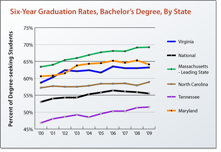
College Ed Xpress is sent to you compliments of: Mid-Hudson Valley FCU
Date: November 2014
|
Let's say you're the parent of a B-C student who just happens to be a really good kid and it's time to begin taking applying to colleges seriously. What do you do? Start looking at the state or private colleges with under 5,000 students. |
 |
There isn't the same rush to apply as early as the more competitive ones like Harvard or Yale. Many professors send their own children with average grades to the smaller schools because they are offered smaller classes, personal attention, and encouragement. Sometimes financial aid is offered as an incentive to have your student enroll.
Desperate Times Call for Desperate Measures-- But Are They Really?
If you were a job seeker without any family responsibilities, and the opportunity for gainful employment in your region were bleak, would you take a good paying job doing something you liked 1,000 miles from home for a period of four years? What if you knew that you could come home and visit every few months and stay home summers? What if you would have something valuable to show for your time away, like sharper and more marketable skills that would likely translate into a higher salary and a brighter future?
Is it just possible you would consider this? It's reasonable to assume you would. There are many out-of-state public universities that offer internships and great networking opportunities at very affordable prices (when comparing costs and real educational value elsewhere). South Dakota has some pretty good schools that cost under $20,000!
There are application strategies that can help as well. Some strong colleges are looking for more geographic diversity, and will consider students with weaker grades if they are from another part of the country.
Look for colleges with pre-admission programs to ease your student into the college he or she plans to attend.
By doing a little homework, you can also find faculty who have earned advanced degrees from top tier colleges-- including Harvard, the University of Chicago, and Dartmouth-- and are currently teaching at "lesser known" schools. Imagine, top teachers at wholesale prices!
Graduation Rates Interpreted
You may or not be aware that based on U.S. Department of Education data, only 53% of college students graduate in six years. Can you afford for your student to have a 53% chance of success in six years. Don't you want your son or daughter to have a 100% chance of success in four years?
And about a quarter of freshmen don't return for their sophomore year. So half the problem occurs by the end of the first year.
 |
What the data actually says is that of first-time college students, only 53% graduate from the institution where they begin their studies within six years. Many will graduate from other institutions.
A good college fit goes a long way toward reducing the 25% failure rate between the freshman and sophomore year. So choosing the right college for the student is important. The factors that seem to conspire to keep young people in college forever are: |
- Parents let them
- Students don't go to class everyday
- Students change their majors too much and too late
- Students go to too many schools, or they transfer and lose credits
- A lack of adequate funds or a family crisis may keep a student away for a semester or more
- Working during college also can delay the process of getting out as can postponing required courses for one's major because a class is oversubscribed
- Schools make it difficult to get required classes
This has become such a concern that the Dept. of Ed. requires colleges to at least report their six-year graduation rates. Another factor that drives down graduation rates are the number of Pell Grant recipients who are right out of high school and either aren't prepared for the rigors of independent study or they just can't receive enough money to finish.
NOTE: The older the Pell Grant recipient (non-traditional student) the more likely they are to graduate than their younger counterparts.
My suggestion is to have a head-to-head talk with your student about what you're willing to do and what they're willing to do. Having a game plan to be successful in college is just as important as applying to college.
High School Juniors: Test Prep Now
Chances are that your junior took the PSAT last month. You will have to wait until December before you know the score. But losing two months waiting without doing some test prep is just foolish.
The junior year is the most important and the test scores, as I've often said are the key to merit funds as well as need-based grants.
Building one's vocabulary takes longer than learning any other skill. Now is the time-- especially if your student is not strong in math or hasn't taken Algebra II yet. Making a good showing on the verbal portion will be very important, so encourage your student to use the time between now and next Fall wisely.
|
One thing your student can do is to take the initiative and sign up for The Official SAT Question of the Day and have math and verbal questions sent to their email. You can be cc'd as well and you know what? It's kind of fun. This can be a way to stay connected with your student through the process. Of course, it won't help unless your student checks their email, which too many don't these days. It's too bad the questions can't be sent by text! However, your student might be more inclined to use the College Board's new iPhone app: Download the Official SAT Question of the Day app for iPhone. |
 |
The reason a lot of students don't "test well" on these standardized tests is that these tests are not the same as those that are taken in class. It's no wonder that students are unprepared and as we have heard countless times, being prepared is half the battle.
| Financial Aid Question of the Month: | |
|
Q. When is the best time to start preparing for the financial aid forms? A. This is a great question and one that is easy to answer AND that answer is right now. Imagine you were doing tax planning. You wouldn't wait until April 15th. You'd start earlier than that. Strategies must be created, tactics executed. Completing your tax return is merely a step in the process. The same is true of the financial aid planning process. Your planning is reflected in the financial aid forms. |
 |
|
Doing everything possible to present a favorable financial aid picture requires planning, familiarity with the rules, regulations, proper completion of the financial aid forms and of course, meeting deadlines. These days, applying for financial aid is a minefield designed to lessen your chances of getting money. The only way to make it safely through a minefield is to follow someone with the map...and we have the map. |
|
'Till next month,

P.S. If you find this newsletter helpful to you please share it with other parents like yourself!
